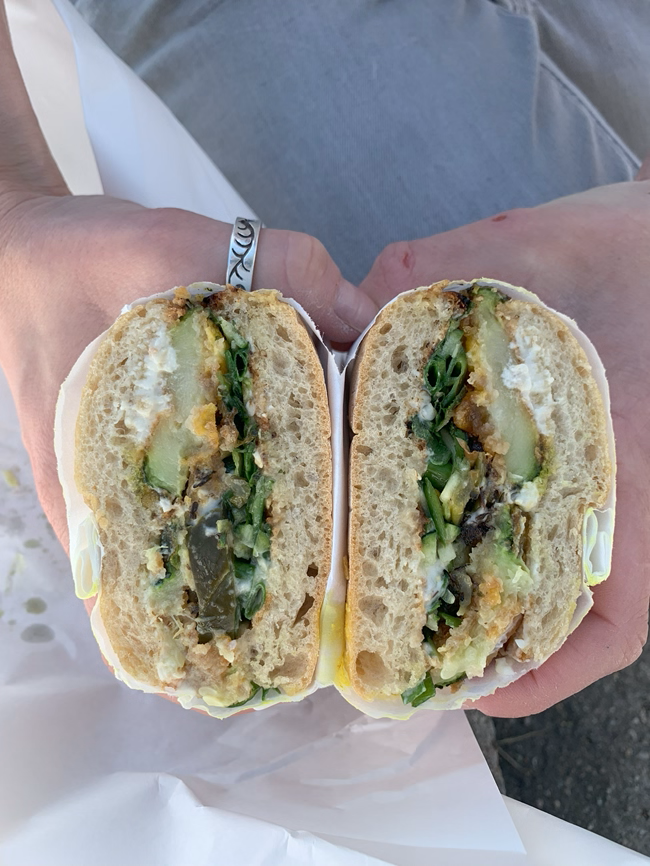Your Everything Guide to Paris Street Food
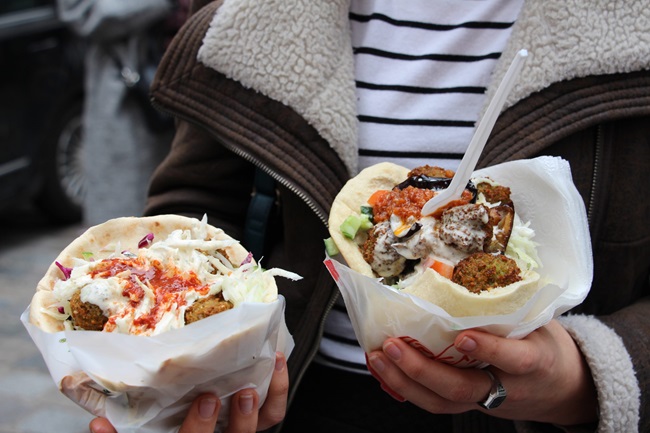

- SUBSCRIBE
- ALREADY SUBSCRIBED?
BECOME A BONJOUR PARIS MEMBER
Gain full access to our collection of over 5,000 articles and bring the City of Light into your life. Just 60 USD per year.
Find out why you should become a member here.
Sign in
Fill in your credentials below.
New York is synonymous with its hot dog carts; Italy has cones of deep-fried seafood tailor-made for walking; Osaka is beloved for its fried takoyaki. But in Paris, street food is far from the norm. Pizza is sold in pies made for eating with a fork and knife, and even burgers, while omnipresent, are more likely to be found on bistro menus than drive-thru windows. As for native street food options, it’s hard to think of anything aside from the roasted chestnuts sold under the stone archways of the Louvre.
This wasn’t always the case. According to Patrick Rambourg, culinary historian and author of Histoire du Paris gastronomique – Du Moyen Age à nos jours, medieval Paris was rife with roving cooks selling pastry-wrapped meat pies out of rolling carts, and gastronomy guide Allison Zinder cites concurrent rissoles, “a savory turnover stuffed with either meat or fish and then fried,” she says. “Almost like what we call a pasty in Great Britain.” Paris’ oldest bridge was once home to peddlers of early French fries dubbed pommes pont-neuf, and these, according to Rambourg, were available well through the 18th century.

A barquette of frites. Photo: Popo le Chien / Wikimedia commons
But these days, street food options are thin on the ground. While massive paella pans sizzle with rice and seafood at weekly marchés, portions are packaged to eat at home. And while some festivals like the Fête des Vendanges de Montmartre or Rock en Seine boast tartiflette or grilled hot dogs for enjoying on the go, these are an anomaly.
“I don’t think street food is in our culture,” muses culinary journalist Stéphane Méjanes, who notes that the gastronomic French meal as recognized by UNESCO is a structured, sit-down meal of many courses, enjoyed on plates and at a table. “I think that sincerely, culturally, we are not a street food country.”
For the most part, Paris’ street food scene has indeed come from elsewhere. Crêpes may well have been the first arrival on the capital’s culinary landscape. The 19th century arrival of train travel from Brittany saw a proliferation of Bretons in Paris, and soon, the neighborhood around Montparnasse train station was dotted with crêperies. While in many cases, crêpes and galettes are eaten seated, a long-held Rennes tradition of galette-saucisse, a sausage wrapped in a buckwheat crêpe, may well have inspired the now commonplace practice of taking galettes to go.
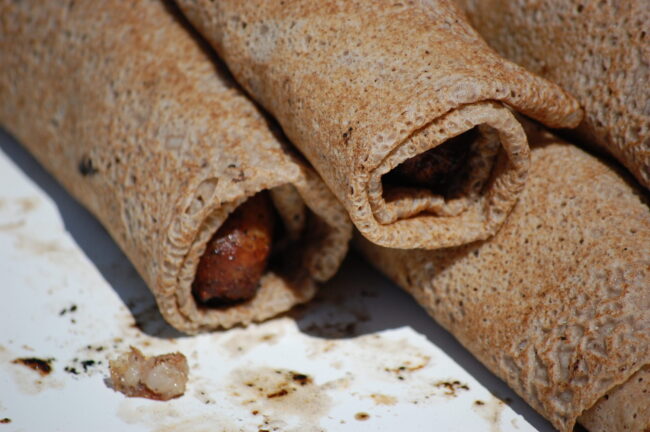
Galette saucisse, a specialty from Brittany. Photo: Trizek / Wikimedia commons
Perhaps the most democratized street food in Paris today is the kébab, which first arrived in France in the 1980s with a wave of Turkish immigration. Today, the kébab is as French as the baguette, with 250 million kébabs consumed nationwide in 2008 alone.
It was in 2011 that food trucks arrived in Paris thanks to Le Camion Qui Fume, which pioneered the gourmet burger to go, though this trend never took off quite as well as in cities like Montreal or Portland. This, according to Rambourg, is partially due to the intense regulations governing where and when such establishments can be open.
“I mean maybe we’re talking about a year and a half, two years before they all either closed up, only did events, or opened actual, physical spaces,” recalls journalist Lindsey Tramuta, author of The New Paris and the New Parisienne.
View this post on Instagram
More recently, with the rise in street food’s popularity around the world, a social media-driven frenzy of la street food overwhelmed Paris with all sorts of concept-driven offerings, from international imports like banh mi and tacos to maximalist creations like croque monsieurs and cordons bleu reimagined to go.
A few true-blue street food offerings do nevertheless exist in Paris, chief among them the humble jambon-beurre you’ll find at nearly every local boulangerie. Whether deeply rooted in French flavors or arrivals from far-flung lands, here are some of our favorite street food options in Paris today.

Jambon-beurre. Photo: Kim/ Flickr.
Chez Aline
85 Rue de la Roquette, 75011 Paris
You can find a decent baguette sandwich at nearly every bakery in Paris, but if you want a great one, go to Chez Aline. This former horse butchery was first converted into a top-notch sandwich counter by Delphine Zampetti, and it’s just as excellent since Tiphaine Moindrot took the reins. The ham-and-butter with Prince of Paris ham is tough to beat, but the Spanish-style tortilla with chorizo is also excellent.
Chez Ibo
218 Rue Saint-Maur, 75010 Paris
Paris is home to countless kébab shops, but this one is a step above the rest. The current owners are brothers who inherited the shop from their father, who founded it back in the’80s after working in the business since 1964. A combo of veal and lamb is cooked until crispy and caramelized before being piled onto baguette customers grab at the bakery across the street for the freshest sandwich possible.
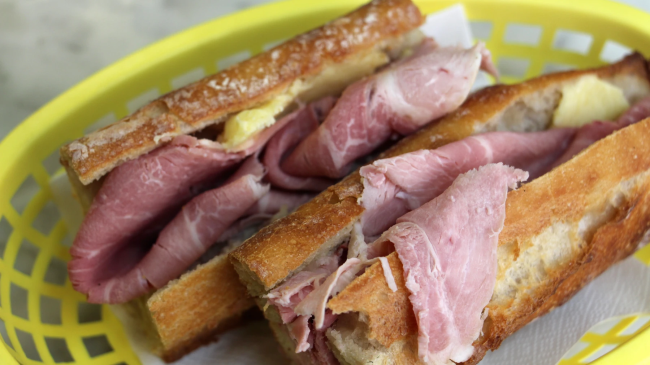
Chez Aline. © Emily Monaco
Plan D
22 Rue des Vinaigriers, 75010 Paris
For a generous, moreish plant-based sambo, head to Plan D, where an ever-changing menu boasts two colorful, seasonal sandwiches at a time. The “Brun” features a chicken-fried portobello mushroom with pepper sauce, onion-mushroom compote, and roasted Jerusalem artichoke, while the “Violet” sees purple potato croquette seasoned with sumac-spiked mayo, crisp red cabbage salad, Chioggia beet carpaccio and harissa secret sauce.
Chez Alain Miam Miam
26 Rue Charlot, 75003 Paris
A stalwart of Paris’ oldest covered market, Chez Alain is a crêperie to be reckoned with. These overstuffed galettes look more like burritos than their demure Breton cousins, stuffed with your choice of cheese, charcuterie, and fresh veg. The line is always massive, but it’s well worth the wait.
Le Cèdre
6, rue Mouffetard, 75005 Paris
This tiny Lebanese restaurant offers a short list of excellent sandwiches, including a truly top-notch chicken shawarma with pickles, creamy garlic sauce, and sautéed potatoes bundled in a flatbread blanket. Get the sandwich on its own or add two mezzes like hummus, stuffed grape leaves, marinated sheep’s milk cheese, or chicken liver with pomegranate.
L’As du Fallafel
34, rue des Rosiers, 75003 Paris
It’s probably illegal to make a list of the best street food in Paris without a mention of this spot in the heart of the Marais. Founded in 1979, l’As is still going strong, with lines out the door every day. Luckily, they move quickly given the efficient ordering policy: Your order is taken – and paid for – while you queue, so when you make it to the window, all you need to decide is if you want hot sauce. (You do.) The falafel is tasty and fresh, but the tender fried eggplant is the sleeper hit of this sambo. The shop is closed for Shabbos from Friday night to Saturday.
Le Daily Syrien
55, rue du Faubourg Saint-Denis, 75010 Paris
Vying for a tie for Paris’ best falafel with its far more famous cousin is le Daily Syrien. Instead of the soft pita pocket preferred at l’As, here you’ll find your crisp falafel wrapped in a thin saj; alongside the falafel and hummus, you’ll find not just eggplant but cauliflower and pickled turnip. And if falafel isn’t your jam, you’ll also find kebbé, shawarma, moussaka, and more.
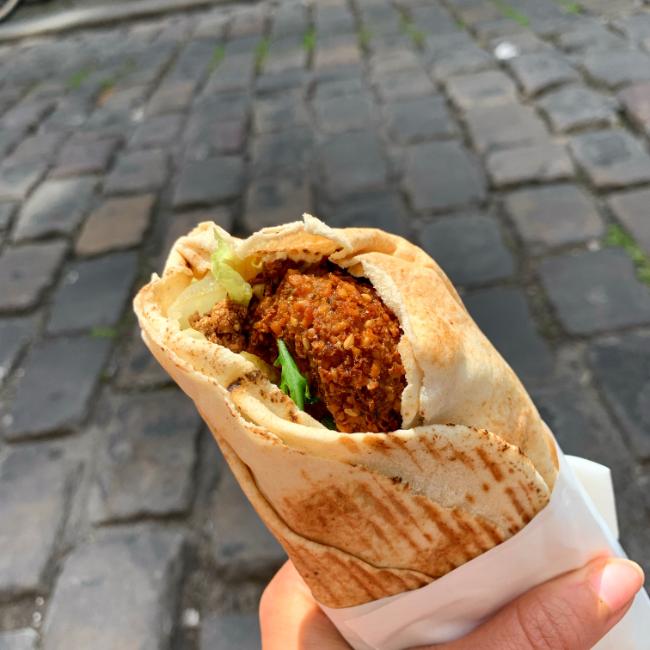
Le Daily Syrien. © Emily Monaco
Nonette
71, rue Jean-Pierre Timbaud, 75011 Paris
This little storefront in the 11th knows what it’s about. Nonette’s famous banh mi start with Vietnamese-style baguette with top-notch French butter and your choice of fillings, from lemongrass-infused roast chicken to house-made charcuterie. Vegans will go gaga over the tender sautéed aubergines with plant-based mayo. Be sure to snag a donut for dessert: Fillings range from lemon-meringue or cinnamon to pork floss or the house-made kaya, a nod to the co-founder’s Singaporean origins.
Urfa Dürüm
58, rue du Faubourg Saint-Denis, 75010 Paris
This Kurdish spot has been a street food go-to for over 30 years, beloved for its Turkish flatbreads topped with your choice of beef, chicken, or lamb, cooked over a wood fire until smoky but still resolutely juicy. The meat and bread are topped with tomato, onion, and herbs for a smoky, satisfying sandwich that needs no sauce to reach the pinnacle of perfection.

Urfa Dürüm. © Emily Monaco
Mamiche
45, rue Condorcet, 75009 Paris
At Mamiche, the simple baguette sandwiches you’ll find at most boulangeries are supplanted by other creations, like a chicken club with fresh tomato and lettuce on house-made sandwich bread, le Petit Niçois with tuna and frisée on a fluffy roll, or the most savory sardine rillettes on slices of grainy loaf. Be sure to snag a donut for dessert!
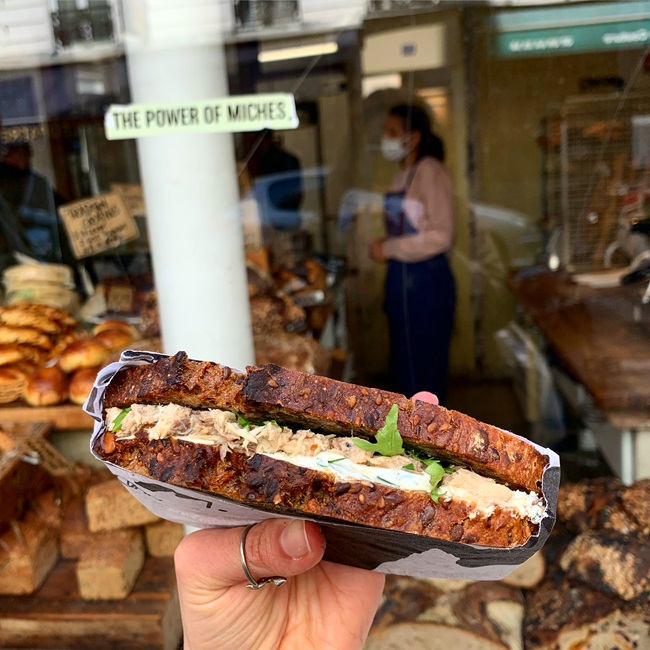
Mamiche. © Emily Monaco
Olga
3, rue Michel Chasles, 75012 Paris
True turophiles (read: cheese lovers) should waste no time in hitting up Olga, a tiny cheese shop steps from Gare de Lyon that’s become known for its lunchtime sandwich creations. Discover the daily recipe, which changes with the seasons and may include dry and fresh goat cheeses paired with spring onion chutney, spring garlic-infused tomme with carrot pickles, or bleu d’Auvergne and preserved cherries.
View this post on Instagram
Coupi Bar
48, avenue de la Porte d’Ivry, 75013
This “street kitchen” at the southern limit of the city is beloved for its banh mi, which may be filled with pâté and Vietnamese sausage, breaded and fried tofu, karaage-style chicken, and more. But they also go off-book with a fusion taco filled with barbecue and peanut sauces and the meat of your choice. Don’t miss the Ice Coupi, a double espresso with condensed milk and cinnamon, served over ice.
View this post on Instagram
Homer
21, rue Rambuteau, 75004 Paris
American-style lobster rolls get the vaguest of French twists at this spot in the Marais, where French blue lobster is piled onto buttery brioche and served with your choice of house-made mayo, Old Bay-spiked guac, or Peruvian pepper. Pay a bit extra for a Connecticut-style version with hot lemon butter. The quality of the ingredients really shines here; it’s no wonder they were named “celebrity favorite” at the World Lobster Roll Championship – in Portland, Maine, no less.
View this post on Instagram
Père et Fish
67, rue du Faubourg Poissonnière, 75009 Paris
Say what you will about the Brits: They know how to make a standout fish and chips. And while most Parisian iterations are sorely lacking in both flavor and crunch, at Père et Fish, you’ll have no such complaints. Here, responsibly sourced pollack is coated in a ginger-spiked batter and fried until shatteringly crisp and a deep mahogany brown. This spot also makes a killer fishburger, whether it’s the Cheddar, with panko-coated pollack topped with cheese, tartare sauce, and pickles, or the Spicy, with battered-and-fried fish smothered in a spicy glaze and sriracha mayo.
Voir cette publication sur Instagram
Caractère de Cochon
42, rue Charlot, 75003
This storefront may look like a simple charcuterie shop, but come lunchtime, the meal deal is a must. Choose from the expertly sourced hams and salamis here to make your own sandwich, served hot or cold, with or without cheese. (And be sure to take home a truffle- and parmesan-coated hockey puck of saucisson for your dinner.)
View this post on Instagram
El Nopal
3, rue Eugène Varlin, 75010
Paris’ first taqueria is still its best. Since 2010, this little storefront has been making some of the tastiest tacos you’re liable to try this side of the Atlantic – and since the Canal is just steps away, you won’t have to take them far to sit down before digging in. The birria, long a secret menu staple, has finally joined the permanent weekend offering, but fillings may also include slow-cooked cochinita pibil or excellent chicharron.
View this post on Instagram
Lead photo credit : L’As du Fallafel. © Emily Monaco
More in Street food
